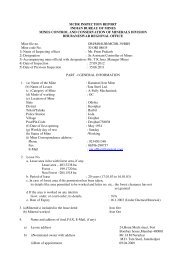Market Survey on Copper - Indian Bureau of Mines
Market Survey on Copper - Indian Bureau of Mines
Market Survey on Copper - Indian Bureau of Mines
You also want an ePaper? Increase the reach of your titles
YUMPU automatically turns print PDFs into web optimized ePapers that Google loves.
2020. In the meantime the mill will be kept up to its 182,000 t<strong>on</strong>nes per day capacity<br />
with sulphides from Radomiro Tomic and Alejandro Hales. The underground mine<br />
will start up in 2018 and when it reaches full capacity <strong>of</strong> 120,000 t<strong>on</strong>nes per day in<br />
2030, the balance <strong>of</strong> the t<strong>on</strong>nage will come from the Alejandro Hales underground<br />
mine. It is estimated that extractable underground reserves below the present pit total<br />
1,150 milli<strong>on</strong> t<strong>on</strong>nes <strong>of</strong> ore gradeing 0.76% copper and 0.052% molybdenum.<br />
This remarkable mine was for many years the world's largest annual producer<br />
until overtaken recently by Esc<strong>on</strong>dida and it is <strong>on</strong>e <strong>of</strong> the largest ever copper mining<br />
excavati<strong>on</strong>. It has produced over 29 milli<strong>on</strong> t<strong>on</strong>nes <strong>of</strong> copper in total, far more than<br />
any other mine.<br />
ii) Radomiro Tomic<br />
The Radomiro Tomic deposit, 5 km north <strong>of</strong> the main pit, was discovered in<br />
1952 after an extensive churn drilling programme to explore for oxidised ore to the<br />
north <strong>of</strong> the Chuquicamata pit. It was named Chuqui Norte but they did not develop it,<br />
largely because the technology had not been developed, particularly SX/EW. Two<br />
smaller areas <strong>of</strong> interest were found and the overall results showed that the<br />
Chuquicamata complex <strong>of</strong> mineralised porphyries is no less than 14 km l<strong>on</strong>g.<br />
The deposit is covered with some 100 metres <strong>of</strong> alluvium and in 1993/94<br />
Codelco estimated a resource base for the operati<strong>on</strong> <strong>of</strong> 802 milli<strong>on</strong> t<strong>on</strong>nes <strong>of</strong> oxide ore<br />
grading 0.59% copper and 1,600 milli<strong>on</strong> t<strong>on</strong>nes <strong>of</strong> refractory (sulphide) ore. The<br />
deposit covers an area <strong>of</strong> 5 km x 1.5 km.<br />
Mining started in 1997 and is again a c<strong>on</strong>venti<strong>on</strong>al truck and shovel operati<strong>on</strong><br />
followed by crushing, pre treatment and stacking before acid leaching. <strong>Copper</strong> is<br />
extracted by SX/EW. Leached ore is removed by bucket wheel excavator followed by<br />
sec<strong>on</strong>dary leaching. It is likely that the 'refractory' sulphide ore will be mined and<br />
used to keep the Chuquicamata mill full during the changeover to underground<br />
mining.<br />
Northern Expansi<strong>on</strong> <strong>of</strong> Mina Sur<br />
Between the main pit and Mina Sur there remains a substantial t<strong>on</strong>nage <strong>of</strong> socalled<br />
exotic copper in the channel <strong>of</strong> paleogravels (ancient gravels) between the two<br />
and which were mined in Mina Sur. The minerals, thought to be deposited by<br />
colloidal copper soluti<strong>on</strong>s leached from the main deposit, included manganese bearing<br />
copper pitch and copper wad, al<strong>on</strong>g with other impurities which made the ore difficult<br />
to leach in the original vats and produced a substandard cathode. The 'exotic' ore is<br />
now being heap leached and the copper extracted by SX/EW which leaves the<br />
impurities behind in the leach soluti<strong>on</strong>. It is expected that this operati<strong>on</strong> will produce<br />
129,000 t<strong>on</strong>nes <strong>of</strong> good quality copper cathode annually.<br />
Sec<strong>on</strong>dary Waste Dump Leach<br />
This is the leaching <strong>of</strong> certain copper bearing waste dumps and is expected to produce<br />
26,000 t<strong>on</strong>nes <strong>of</strong> copper annually.<br />
174<br />
C<strong>on</strong>td…..
















